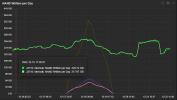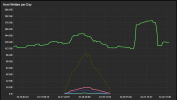Hi all! New to this forum and read a lot recently about Proxmox installation. Most of the answers I've gotten with just searching but this topic still puzzles me a bit.
Just a little backgroud first. This is going to be my first Proxmox install and a first time trying type 1 hypervisor. I've been running a home server for a few years on Ubuntu. I went with ZFS storage for HDDs from the start and have been happy with it. My OS install is currently on a mdadm mirror (2x Samsung 870 Evo 256Gb). I'm quite familiar with Linux and know atleast the basics of ZFS. I have not however tried ZFS for OS install.
I've read that Proxmox on ZFS is available as a option from the installer, but one should really consider the SSDs endurance if ZFS is chosen. Those Samsungs are OK'ish consumer drives but they dont have petabytes of write endurance. As far as I understand, Proxmox does quite a lot of logging and this combined to ZFS write amplification, can kill a "normal" SSD surprisingly fast. And this would happen even without the VMs running on the same disks. I have 2x1Tb Firecuda 530 drives just for those and a separate HDD pools for storage.
Here are a few options that I currently consider:
1. Just go with ZFS and deal with the drives when time comes. Not exactly ideal, but small SSDs are not that pricey anymore, so it is worth considering because of the benefits of ZFS.
2. Start with Debian, install on Raid1 mdadm and install Proxmox packages on top. Sounds good to me, but going even this much on the "custom" path makes me a bit uneasy. How common are these types of installs?
3. Install on just one drive, set up robust backups and just swap the drive if needed.
4. Something else?
Am I on the right track? None of the options I have found sound ideal. Most likely I would be going with number 3 of those, since a home server can have some downtime for repairs. The SLA is very lenient around here.
Just a little backgroud first. This is going to be my first Proxmox install and a first time trying type 1 hypervisor. I've been running a home server for a few years on Ubuntu. I went with ZFS storage for HDDs from the start and have been happy with it. My OS install is currently on a mdadm mirror (2x Samsung 870 Evo 256Gb). I'm quite familiar with Linux and know atleast the basics of ZFS. I have not however tried ZFS for OS install.
I've read that Proxmox on ZFS is available as a option from the installer, but one should really consider the SSDs endurance if ZFS is chosen. Those Samsungs are OK'ish consumer drives but they dont have petabytes of write endurance. As far as I understand, Proxmox does quite a lot of logging and this combined to ZFS write amplification, can kill a "normal" SSD surprisingly fast. And this would happen even without the VMs running on the same disks. I have 2x1Tb Firecuda 530 drives just for those and a separate HDD pools for storage.
Here are a few options that I currently consider:
1. Just go with ZFS and deal with the drives when time comes. Not exactly ideal, but small SSDs are not that pricey anymore, so it is worth considering because of the benefits of ZFS.
2. Start with Debian, install on Raid1 mdadm and install Proxmox packages on top. Sounds good to me, but going even this much on the "custom" path makes me a bit uneasy. How common are these types of installs?
3. Install on just one drive, set up robust backups and just swap the drive if needed.
4. Something else?
Am I on the right track? None of the options I have found sound ideal. Most likely I would be going with number 3 of those, since a home server can have some downtime for repairs. The SLA is very lenient around here.
Last edited:



